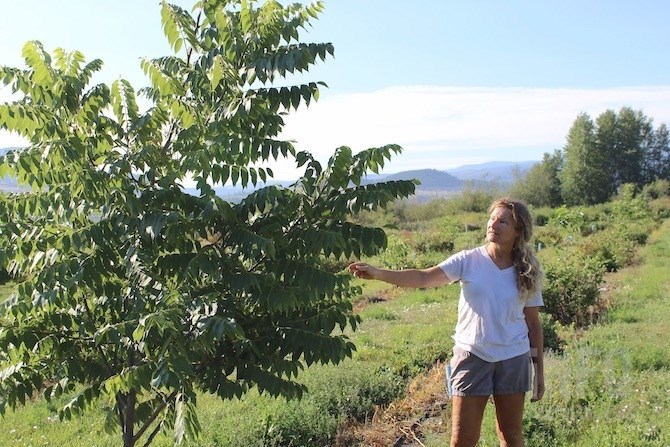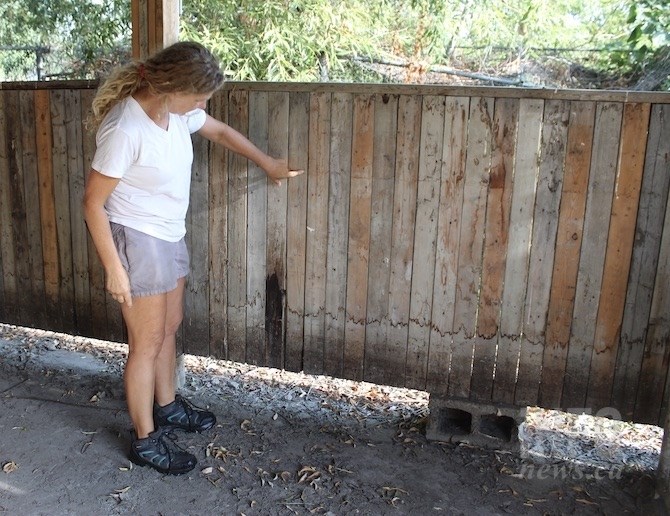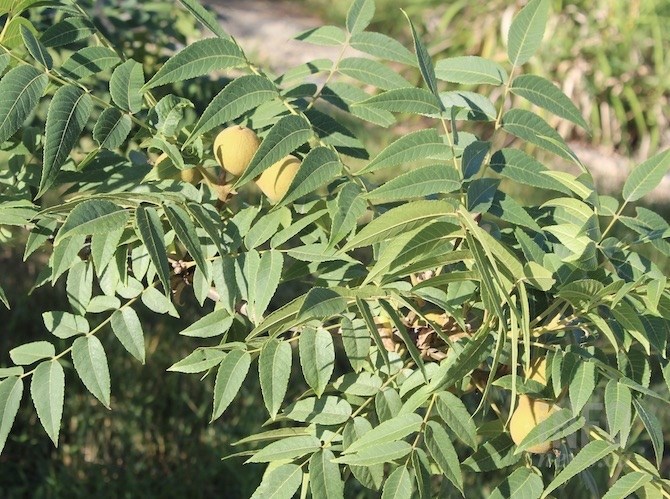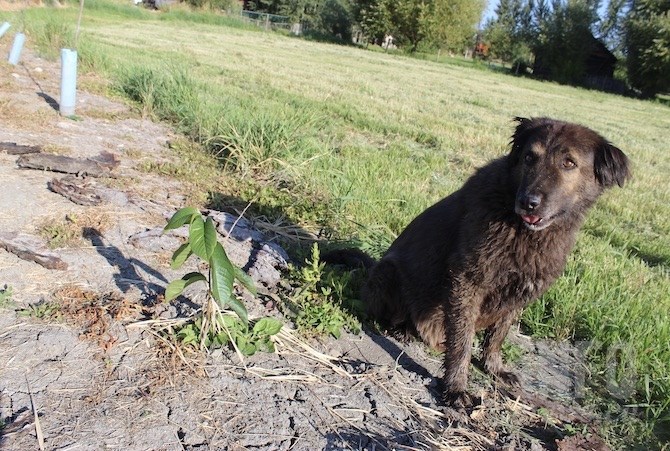
Brenda Dureault is the owner of Curly Frog Farm and is growing black walnuts because they can tolerate being under water in the spring.
(ROB MUNRO / iNFOnews.ca)
August 13, 2020 - 7:00 AM
When Brenda Dureault bought a 26-acre hayfield from her father 20 years ago it was supposed to be just that, a hayfield used for grazing cattle.
“I was told it would flood maybe once every 10 years,” she told iNFOnews.ca. “It might have been true back then but the land has changed dramatically.”
Part of the change might have been caused by the industrial development next door where the land has been paved over. A part could be the pasture being filled in across Hereron Road from her Curly Frog Farm or it may be mountain pine beetles killing forests in the Mill Creek watershed, causing snow to melt faster and flood her fields.
The reality is, her first flood came in 2004. That year she lost her farmland exemption because she could no longer grow hay and graze cattle.
Some years she has a 10-acre lake she paddles her canoe in.
“It’s kind of nice to have waterfront property,” Dureault said, jokingly.
She shows water marks about three feet up the wall of her former chicken coop. That was the 2017 flood. Often the water sits for a month and leaves stains lower down that wall.

Brenda Dureault points to where flood waters reached in 2017.
(ROB MUNRO / iNFOnews.ca)
That meant she had to invent an entirely new way of farming for what has turned into a wetland in the middle of the dry Okanagan and creating what is, to a large extent, a black walnut farm.
In doing her research she was told, initially, that celery would grow on such wet land but she couldn’t see herself being able to manage a 26-acre celery field, let alone finding a market.
She talked to the Ministry of Forests and started learning about something called agroforestry.
“That is, growing forestry crops with agricultural crops in the same setting,” Dureault explained.
That’s where the black walnut came in. Not only can it survive being flooded most springs and still produce nuts, but it’s also a valuable source of lumber.

These are black walnuts.
(ROB MUNRO / iNFOnews.ca)
Interplanted between the walnut trees are things like mulberries that can tolerate the toxic juglone that is produced by the walnuts in its roots and its leaves. It takes a few years to build up enough to kill most other plants but the white mulberry thrives next to them.
She’s also experimenting with other nuts, such as hazelnuts, English Walnuts and yellow horn along with other crops, such as Christmas trees.

The yellow horn bursts open and spills small nuts on the ground when they're ripe. Collecting them can be time consuming but "that's what grandchildren are for," Dureault joked.
(ROB MUNRO / iNFOnews.ca)
In 2014 she partnered with the B.C. Wildlife Federation to create chinapas. Adapted from an ancient Aztec technique it meant creating wetland channels and using the soil to build up higher banks on either side suitable for planting, in her case, pawpaws.
This fruit is similar in size to a mango and has a “tropical flavour.” She got her plants from the Niagara Peninsula in Ontario because they can tolerate the flooding and the walnuts. It’s a fruit tree that is native to the eastern U.S. and Canada.
On the ridges, she has rows of plastic tubing with tiny pawpaw plants inside because they cannot tolerate the sunlight for the first two years of life then craves the sun.

Dureault's dog Moose sits next to a pawpaw tree that's old enough to tolerate the sun. Younger trees have to be shielded for the first two years.
(ROB MUNRO / iNFOnews.ca)
“This is experimental,” Dureault said. “There are things I would do differently. I would build these (ridges) taller and I would definitely make the canal deeper so it doesn’t get overrun with cattails, so you have a different set of plants in the wetland.”
The wetland is not productive farmland but it brings in different wildlife species – including herons – and birds that help control bugs.
“It’s a huge learning curve,” Dureault said. “There is nobody else to talk to about it. It’s been a lot of trial and error.”
The walnut trees have to be tied to bamboo stakes when first planted so their trunks will grow straight. Limbs over two inches in diameter are removed with the goal of growing a 10-foot long defect free bole suitable for veneer.
That will take 30 to 40 years to produce lumber.
She does harvest the nuts and shells them by hand to sell at farmers markets. But, to be commercially viable, there needs to be an affordable commercial sized machine to break the tough black walnut shells and separate them from the meat. She did try to get engineering students from UBCO to create one but that effort failed.
READ MORE: Why Okanagan nuts never blossomed into a commercial crop
This is not the kind of farming that’s economically viable right now. Dureault works as a landscaper four days a week and sells crafts during the winter.
Because these are perennial crops they only require pruning and the grass needs to be mowed so they’re much lower maintenance than many other types of farming.
“I love it,” Dureault said standing in her walnut orchard. “It’s the idea of the perennial farming. Designing a new way of agriculture or an alternate. I find it fascinating. It’s not going to make me rich, but there’s more to it than that. It’s a contribution to the agriculture industry.”
Dureault isn’t the first to grow nut trees in the Okanagan. That was started by Jack Gellatly at what is now the Gellatly Nut Farm Regional Park. And she knows of maybe a dozen other nut growers in the valley. She even bought some of her walnut seedlings from a Lake Country nut farm that’s now gone.
READ MORE: West Kelowna's nutty roots are unique to the Okanagan, and due to the Gellatly family
“Wouldn’t it be nice to have a nut industry here, to have a diverse set of perennial food, other than just fruits?” Dureault asked. “Jack Gellatly did all the breeding and stuff but it stopped right there. Wouldn’t it be nice to move that forward?”
For more on the Curly Frog Farm, go to her web page here.
To contact a reporter for this story, email Rob Munro or call 250-808-0143 or email the editor. You can also submit photos, videos or news tips to the newsroom and be entered to win a monthly prize draw.
We welcome your comments and opinions on our stories but play nice. We won't censor or delete comments unless they contain off-topic statements or links, unnecessary vulgarity, false facts, spam or obviously fake profiles. If you have any concerns about what you see in comments, email the editor in the link above.
News from © iNFOnews, 2020